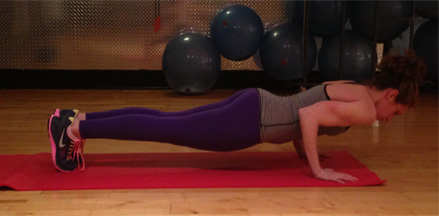
If I were to sum up this week, I’d say it in one word….GRATEFUL! My birthday was last week and on the actual day, I did the things that I loved and would make me happy (run in the park and a workout, hang with my dog, day at the spa, delicious meal, and time with my fiancee). The one thing that would have made it more perfect would be to spend time with my family and closest friends. The week was filled with gifts, dinners, messages of love and affection but most of all moments of retrospection and reflection. And it really got me to think about life and the race we run every day in the ultimate pursuit of attaining happiness.
This weekend, I attended a workshop hosted by Kayleigh Pleas. I’ve had the opportunity to work with Kayleigh a few years back as a fitness instructor. She has taken her fitness talents further and now is a nutrition and wellness coach. Her workshop is called the “How to Happiness” and basically breaks down the science of happiness and how your nervous and endocrine systems work together to produce an overall shift in your body. Kayleigh’s research to support her teaching was extensive studying work from neuroscientist, Rick Hansen to social psychologist, Barbara Frederickson. She started her workshop with a positivity ratio quiz that measures your moments of contentment, gratitude, negativity, boredom, confidence, disgust and so many more emotions on a daily basis. It’s amazing how many emotions we tap into daily. This workshop teaches you how to be mindful of these emotions (especially the negative ones) and to turn them into positive happy ones.
I can’t say that I experience unhappiness as I generally have a positive outlook in life and am a happy-go-lucky person but will admit that living in NYC can wear that down. There are times that I want to barrel through the crowds at the Times Square train station and see how many people I can knock over. Not good and from what I learned in Kayleigh’s workshop, this negative emotion sets off the wheels to create a turmoil of hormones (cortisol and dopamine) to whirl around my body creating stress and uneasiness. I now bring awareness to those emotions once they arise and try to calm myself down before I react. But it takes practice.
Here are some things that I have taught myself to practice daily to remain calm and achieve happiness every NY minute of my day.
#1 Let Go! You can’t possibly be in control of every second in your life. Some things you just have to leave up to faith and fate. If you find yourself on a stalled train and you’re already running behind or if everything has gone wrong since the moment you stepped out your door, then just take a deep breath in and let it all go. Once you start to stress or feel anxious, your hypothalamus (a small but very important part of your brain that links the nervous system to the endocrine system via the pituitary gland) gears up to work. Your system then starts to secrete hormones through your system, your heart begins to pump faster, your digestive system stops during this time, and this cycle continues over and over again. If you stress often and long enough, your physical and mental body will break. Know that every moment you stress or huff in frustration, the less control you have not only of the situation but for yourself as well.
#2 Work It Out! Now that Spring has finally arrived, take your workouts outside. I love to take my clients for a run to Central Park or Washington Square Park. I use the park benches for step ups, push ups, tricep dips, and ab work. Find a set of stairs and use that for cardio. Take a resistance band with you and the exercises are endless. The benefits of exercise are hard to ignore. Physical activity gets your blood flowing smoothly (to help combat cardiovascular disease), delivers oxygen and nutrients to your tissues (improve muscle strength and endurance), help you fall asleep faster and deepen your sleep (to increase mental alertness), stimulates various brain chemicals (improving your mood leaving you feeling happier and more relaxed) and so much more.
#3 Work on Meditating. I am a yogi but I am far from being a guru in meditation. It is one of the hardest things to do. But I make sure I find brief moments of mindful meditation. On my train commute, between sessions, walking to get my lunch are all moments that I take for meditation. Meditation doesn’t only have to be seated in lotus pose on a yoga mat with your eyes closed. It’s what you make of it but most important is to clear your mind of everything but one thing. Neuroscientists have found that meditation shifts brain activity to different areas of the cortex. This mental shift decreases the negative effects of stress, mild depression and anxiety.
I’ve recently started a new meditation where I close my eyes and focus on the noises that surround me. I don’t force myself to hear them but allow the noises to travel in one ear and out the other. It’s surprisingly calming and helps me to focus on this one thing – other than having to sit and meditate. Try it!
#4 Express Gratitude! We all know what we want in life and may have an expectation where we should be in life. Since I just had a birthday, I started to think of these expectations (a baby, owning a home, my own business, a certain amount in my bank account, etc.) that I almost lost track of what I do have. When I start to count my blessings, I automatically feel at ease. Being grateful helps your well being. Psychologists Robert Emmons and Michael McCullough point out the benefits of expressing gratitude as ranging from better physical health to improved mental alertness. We forget about how much we do have: our health, love from our family and friends, and to simply be alive. Take some time today and think of these simple things and be truly grateful for all that you do have.
#5 Stay Connected! In this day in age, when you think of staying connected, you think Facebook, Twitter, email or text to keep in touch with others. But I’m talking about a real connection. And that means to pick up the phone and call, meet with your friends, laugh with your family, and even as simple as making eye contact with a stranger. I love this article in the NY Times, Your Phone vs Your Heart. The more attuned you are with others, the healthier you become. Try smiling or saying good morning to a stranger. You will be surprised how this simple act will brighten that moment. And consider the impact you may have on this stranger.
These are nothing new but these small actions can make a huge impact in your days and your overall health. Attaining happiness is very possible…it just takes a little bit of awareness and lots of practice. Thanks Kayleigh for bringing this to my attention again!
*I’m happy to have Kayleigh Pleas a part of my Community. Visit her site for upcoming “How to Happiness” workshops.







